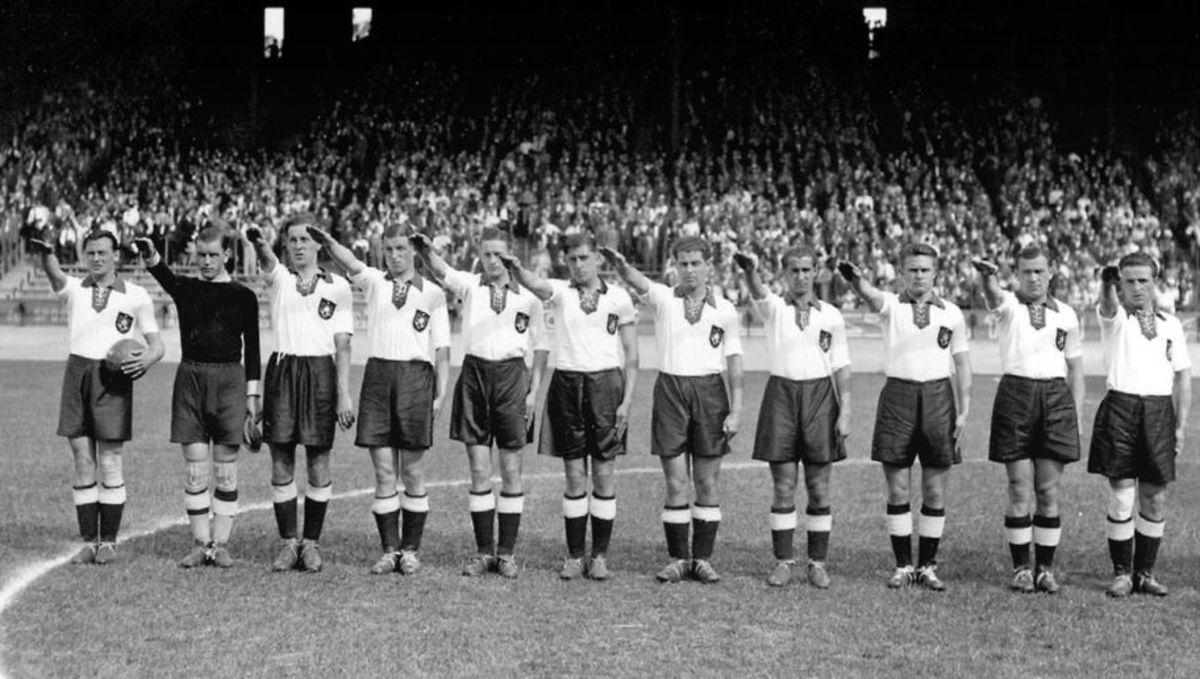World Cup Countdown: 18 Weeks to Go - Nazi Germany & the Reichssportführer's Propaganda Failure

As a fractured combination of the world's most powerful footballing nations bolstered by a smattering of minnows descended onto France in June 1938, the political landscape of the globe was transmuting around them.
Nobody involved could have foreseen the events that then developed over the following seven years; a time which will never be forgotten, nor one that any will want to recall.
However, just over 12 months prior to the deadliest conflict in human history, a disjointed German national side, under the scrutinous watch of the Fuhrer, Adolf Hitler, embarked on a journey through their neighbouring border and on to Paris.
(You may also be interested in'World Cup Countdown: 19 Weeks to Go - Remembering the Infamous 'Battle of Bordeaux')
However the true tale of the national socialist's first, and only, inclusion in the FIFA World Cup starts two years before, in Berlin.
Following a lamentable showing at the 1936 Olympic Games, which saw Nazi Germany succumb to a 2-0 quarter-final defeat at the hands of Magnar Isaksen of Norway, and assistant manager Sepp Herberger, who is known today for leading West Germany to World Cup success in 1954, was instated as head coach, succeeding Dr. Otto Nerz.
The Mannheim of the German Empire-born former striker would go on to oversee the 1937 Breslau Elf - the Breslau Eleven - a side named in recognition of their 8-0 victory over Denmark in the then city of Breslau - now Wrocław - Poland.
(You may also be interested in'World Cup Countdown: 18 Weeks to Go - Karl Rappan's 'Libero' & the Global Icons Who Evolved the Role')
However, despite their increasing success, Herberger's XI, which is still to this day regarded as one of the greatest side's in the country's footballing history, were denied the opportunity to taste the celebration of the game due to the surrounding geographical and political transposition.
Following the Anschluss on March 12, 1938, which saw Austria absorbed into Hitler's augmenting domain, the nation's Wunderteam - who were overseen by legendary Hugo Meisl before his death in 1937 - were disbanded under the command of Reichssportfuhrer Hans von Tschammer und Osten.
However, although their official decimation had been notified to FIFA, which came just 16 days following the annexation, on April 3 the OFB were permitted one final act; a 'reunification' derby, or Anschlussspiel - 'connection game' - to mark the final outing as an independent football team.
The clash inside an adoring, 60,000 brimmed Prater Stadium, Vienna - known today as the Ernst-Happel-Stadion - was an opportunity for the once beloved side to celebrate the Anschluss and the country's 'coming home to the Reich'.
In order to prove the rather amateur - but athletic - representatives of the visiting Altreich were collectively on par with that of the Austrians, and to portray a unified front, a pre-meeting result was determined. The contest was to end in stalemate. However, that did not turn out to be the case.
As time ticked by in what was expected to be Ostmark's somber farewell to world football, chances - perhaps intentionally - continued to go begging. Captain Matthias Sindelar, who had instructed his fellow men to be donned not in their usual black and white dress, but red-white-red - in reference to their nation's proud flag - led his team astray, until the final 30 minutes.
Despite strict orders for the tie to play out goalless, the centre forward of Czech descent, who obtained the nickname Der Papierene - 'the papers' - due to his slender stature, netted two minutes after the strike of the hour, with teammate Karl Sesta doubling that lead eight minutes later.
It is claimed that Sindelar's over exuberant celebration in front of the Nazi dignitaries after breaking the deadlock, as well as his rejection to represent the 'Old Empire' at the World Cup two months later, led to his and his wife's death by carbon monoxide poisoning in 1939.
Despite their defeat, the Sturmabteilung leader, Von Tschammer und Osten, who had played a significant role in the Fuhrer's rise to power, was not to be thwarted, and, alongside a collection of Nazi politicians, ordered nine of the Austrian outfit to trade allegiances and travel to France under the infamous red, black and white flag in a sign of staged unity fuelled by the national socialist's propaganda regime.
Within those rulings, manager Herberger was instructed to collate a world-beating XI with a ratio of 6:5, meaning five Ostmarks were to stand shoulder to shoulder with six Altreichs.
However, even while boasting a core made up of the Wunderteam, alongside Paul Janes, who is ranked in Germany's top 20 footballers of all time, and led by captain and Schalke legend Friedrich Szepan - who was chosen, despite being lambasted for not possessing a German enough name - Hitler's dream of his 'empire' asserting their dominance in the world of sport quickly unravelled.
Although the Reichssportfuhrer saw fit to prepare the Mannschaft zu spielen with a final home soil friendly against the dominant English, which portrayed harrowing scenes of the travelling contingent offering the Nazi salute under the instruction of British Prime Minister Neville Chamberlain; Herberger simply did not have enough time to mould an efficient force.
The 'united' squad, one which Von Tschammer und Ostenhad hoped would strike fear in their opponents similar to he on society, were held to a 1-1 draw against Switzerland in the first-round, only to surrender a two-goal advantage on route to a 4-2 defeat in the replay as they were watched on by a hostile crowd made up mostly of Parisians due to Germany's foreign currency rulings.
The shock exit was, and still is to this day, Germany's worst showing on the pitch at a FIFA World Cup competition since its formation in 1930. Rather fitting for a time which also saw their darkest hours off it.





